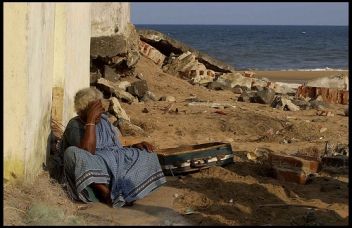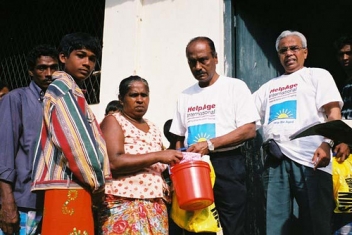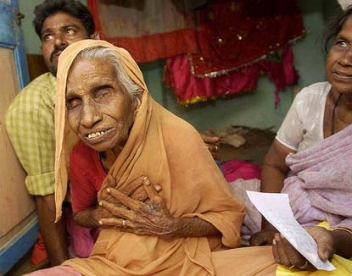 HelpAge International’s East Asia Pacific Regional Representative, Eduardo Klien, looks back at the events that followed the 2004 Indian Ocean tsunami…
HelpAge International’s East Asia Pacific Regional Representative, Eduardo Klien, looks back at the events that followed the 2004 Indian Ocean tsunami…
The 2004 Indian Ocean tsunami not only took us by surprise – it caught us completely unprepared. I had been in HelpAge’s South East Asia office for only three months, and had no idea of what type of response we, as HelpAge, were capable of taking forth.
Our team had only had experience managing some elements of the Gujarat earthquake response. We had little institutional experience in responding to such a huge catastrophe.
Little by little news of the tsunami filtered through a few hours after it had struck. The true extent of the damage was only known the next day. We contacted our network partners who were as perplexed as we were.
Wijewantha and Tilak in HelpAge Sri Lanka, Mathew, Anup and Col Sharma in HelpAge India, Eva in Indonesia…They were all gathering information and preparing their responses, and all of them asking for support from HelpAge.
 Rapid response
Rapid response
The regional office was closed for the holidays, but all staff made themselves available immediately. We held a quick team meeting and decided that we had to support the responses, and fast.
Wesum flew the following day to Sri Lanka, Goddy to India and Quyen to Indonesia, to make a quick appraisal but also to help organise the response.
Wesum, holding back tears, reported the devastation in Galle, a place that he had known since his childhood. He also told of volunteers in Sri Lanka distributing 10,000 relief packages in a couple of days.
Goddy reported how HelpAge India were targeting older people in the chaotic initial distributions of relief packages, by providing coupons or tokens so that they did not need to stand long hours in a queue.
Quyen highlighted his visit to a large warehouse with refugees form Banda Aceh, where he could only count eight older people out of over 600 people there. When he asked why were there so few of them, he was stunned by the response: “They did not have the strength to resist the water, they could not survive three days without food, they were too weak…”
Catastrophe and chaos
 The human dimension of the catastrophe was overwhelming.
The human dimension of the catastrophe was overwhelming.
The first days and weeks were chaotic. HelpAge’s London emergency team sent experts to the different countries to join the teams working there. We had daily teleconferences with Directors in London to update them on the situation and the response that was being developed.
By the first week of January Wesum, Goddy and Quyen were back in the regional office. They shared dramatic stories of what they’d gone through, and also expressed a determination to respond – the need was so great!
In the following weeks the programmes started taking shape. The UK Department for International Development gave us a large grant for relief work in Sri Lanka and India. This was used mainly to distribute food and other essential items, and also to build latrines and provide safe water in the camps.
Then came the planning for the Disasters Emergency Committee response. We went back to the partners to carry out more detailed assessments, trying to focus on the situation of older people. We also documented the situation of older people in the tsunami in a video, Life after the tsunami, and a report The impact of the Indian Ocean tsunami on older people.
The programmes in Sri Lanka and India were developed very rapidly (we say this in hindsight, since at the time everything felt that it was too slow given the scope of the need).
In Indonesia we went for an assessment in the Nias Island preparing for an intervention there, but this was frustrated first by the sudden death in the field of Allain Pillet, Consultant working with Eva and Quyen, and later by the earthquake of March 2005. It is only after that that we established the programme in Banda Aceh.
Long-term response
After a few weeks it became clear that our response had to be long-term, at least two or three years. We were thinking at the time of the tsunami of a gradual change in our structures and capacities, but this was electric shock-treatment. We had to do everything now, in addition to our normal workloads. But we did it, in conjunction with Bill Gray and the London emergencies team.
In the following months and years we saw the humanitarian world deploying responses with all its might and all its shortcomings. We were frequently left wondering how humane the motivation of many people getting involved in the response was, but we also witnessed exemplary attitudes of commitment and professionalism throughout.
As for HelpAge’s East Asia Pacific office staff, we all gained experience and even a few more grey hairs, but we also gained the satisfaction of having responded to the utmost of our capacity at a time of need. Those first few weeks… we would not do it differently. We gained respect from partners, older people and especially from our own selves.
Lessons learnt
We and our partners learned important lessons, both of the practical and ethical kind. We learned how to establish rapid responses, how to target older people in camps, how to mainstream ageing in the humanitarian world, the value of organising older people’s organisations in rehabilitation processes, we learned many things. But the greatest learning was the importance of feeling other people’s suffering as if it were our own, the value of human solidarity.
Watch “Life after the tsunami”
Read more about HelpAge’s work with older people in emergencies.
